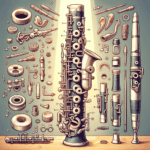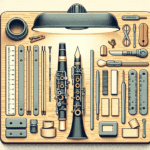Effective clarinet reed placement is key to achieving a beautiful sound. Many beginners don't realize how much the position of the reed on the mouthpiece can affect tone, response, and overall playing experience. Let's explore the specifics of clarinet reed placement and techniques to improve your playing.
Understanding the Anatomy of the Mouthpiece
The mouthpiece is crucial for sound production. It has a flat surface for the reed and a throat leading into the instrument. Knowing how the reed interacts with this structure is key to optimal sound quality. Proper reed placement affects not just sound production, but also intonation and articulation.
Reed Placement Basics
Follow these steps when attaching the reed to your mouthpiece:
- Moisten the Reed: Always wet your reed before placing it. A moist reed vibrates more freely, producing a richer sound.
- Align the Reed: Place the reed so it evenly covers the mouthpiece tip. This alignment ensures optimal vibration and clarity.
- Positioning Depth: Position the reed about one-third down from the mouthpiece tip. This supports the reed's vibration while minimizing unnecessary pressure.
- Secure the Ligature: Use the ligature to hold the reed in place. Don't over-tighten, as this can hinder the reed's natural vibrations.
| Common Issue | Possible Cause | Solution |
|---|---|---|
| Uneven Tone | Misaligned reed | Reposition reed for even coverage |
| Intonation Problems | Incorrect reed depth | Adjust reed placement depth |
| Squeaking Sounds | Over-tightened ligature | Loosen ligature slightly |
Understanding the Reed's Role
The reed is a vital component that greatly affects your sound. A well-placed reed vibrates freely and creates a balanced tone. Poor placement can cause squeaking, muffled sound, or difficulty controlling dynamics. Learning to adjust your reed placement helps you adapt to different musical settings and improve your overall performance.
Common Reed Placement Issues
As you get more familiar with your clarinet, you might face these reed placement issues:
- Uneven Tone: If your tone is inconsistent, check the reed's alignment and position. Small adjustments can lead to a more coherent sound.
- Intonation Problems: If you're consistently sharp or flat, try adjusting the reed placement depth. Small changes can significantly improve pitch accuracy.
- Squeaking Sounds: Unwanted squeaks might be due to an over-tight ligature or misaligned reed. Ensure your ligature holds everything securely but not too tightly.
Experimenting with Placement
Finding the best placement varies for each player. Try different depths and angles to find what works for your style:
- Depth Variation: Start at the one-third distance and make small adjustments. Play scales and passages at each depth to assess tone and intonation changes.
- Angle Adjustment: Changing the reed's angle against the mouthpiece can improve resonance and projection. Notice how these changes affect your comfort and sound.
- Testing Different Reeds: Various reed brands and strengths have unique characteristics. Experiment to find what suits your playing style best.
The Importance of Quality Reeds and Mouthpieces
Good-quality reeds and mouthpieces are essential for optimal sound. Brands like Martin Freres are known for precision and consistency in their mouthpieces. Your reed's quality also affects how it vibrates against the mouthpiece, so choose reeds that match your skill level and playing style.
Notice how different reeds respond to your embouchure. A well-made reed can improve sound transmission through the instrument, enhancing articulation and control.
Regular Practice and Maintenance
Consistent practice and maintenance are crucial for mastering clarinet reed placement:
- Consistent Exercise: Practice different reed placements during warm-ups. Use long tones, scales, and simple melodies to explore how small adjustments affect your sound.
- Healthy Reed Care: Keep your reeds clean and well-maintained. Rinse after playing and store properly to prevent warping and cracking, which can affect performance.
- Reflection and Adjustment: After practicing, think about how reed placement affected your playing. Keep notes to help refine your technique over time.
Learning to properly place your clarinet reed is a step towards becoming a better musician. The right techniques enhance your playing experience and deepen your understanding of the instrument.
With time and care, you'll discover your unique clarinet sound, making your musical journey more rewarding and enjoyable.







